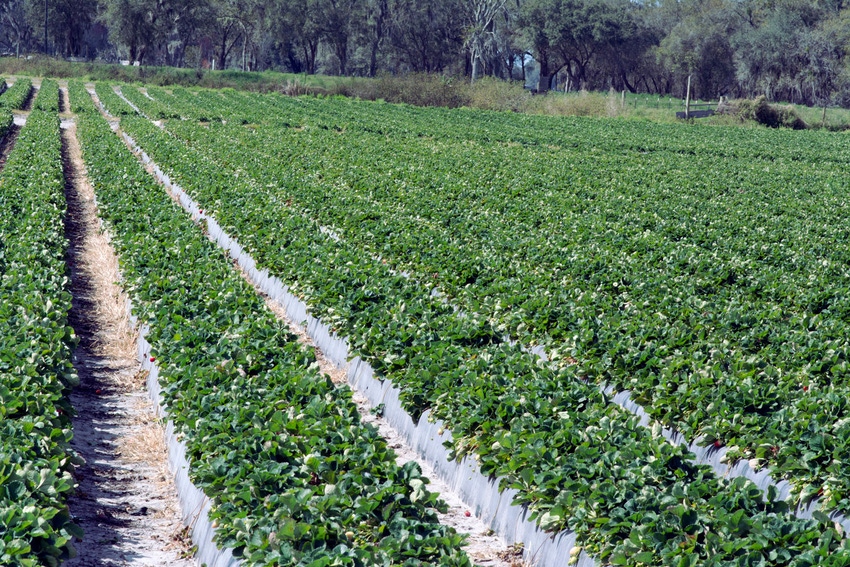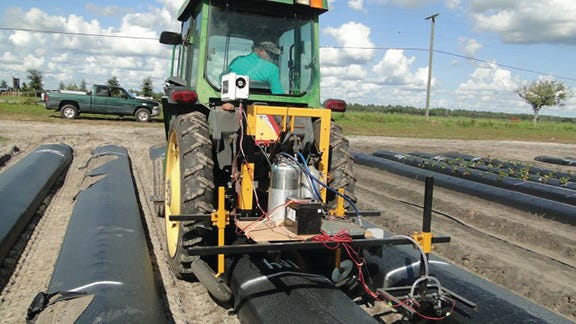
Think of University of Florida scientists Nathan Boyd and Arnold Schumann a bit like surgeons. Except in this case, their operating room is a strawberry field.
With their research, Boyd and Schumann hope to eventually help growers unleash surgical strikes on weeds — without vanquishing their fruit. Additionally, robots may replace tractors as the means for delivering the spray in the field.
Getting rid of weeds is critical for growers in Florida’s $300 million-a-year strawberry industry because weeds hinder fruit yield.
To conduct their studies, the UF/IFAS researchers mount a smart spray system to a tractor-pulled sprayer, which uses the highly targeted process to spray only weeds. So far, they’re killing up to 90% of the weeds. Precise spraying depends on many factors, including the types of weeds that scientists target and the speed of the tractor that sprays the weeds, said Boyd, a UF/IFAS associate professor of horticultural sciences.
Together, Boyd and Schumann — a professor of soil and water sciences at the Citrus Research and Education Center in Lake Alfred — are using artificial intelligence to detect and identify weeds within a crop canopy. The technology also can do the reverse: detect the canopy and spray everything else.
Boyd and his team trained AI programs to scan for weeds in the images collected by a camera. Once detected, a computer sends a signal to the spray system to spray the herbicide only on the weeds.
“This is done while moving through the field on a tractor, so you have to be able to detect weeds and hit a moving target,” Boyd said. No easy task, but it’s worth it. Boyd’s team is also working to improve spray precision at higher tractor speeds.

A tractor operator pulls the machine that UF/IFAS scientists are using to try to get rid only of unwanted weeds — and avoid spraying strawberries — as they spray the plasticulture fields at the UF/IFAS Gulf Coast Research and Education Center. Credit: Nathan Boyd, UF/IFAS.
While the research remains in the preliminary stages, Boyd wants to reduce the amount of herbicide spray strawberry growers use. That saves farmers money and helps cut unwanted chemicals from getting into the environment.
Asked for cost-savings estimates, Boyd gave this example: If you shoot low and anticipate a grower using an inexpensive herbicide that costs $30 per acre and you drop the amount of spray by 50%, you save $15 per acre.
“That doesn’t sound like much, but if you have 100 acres, that is $1,500,” Boyd said. “Then add in the costs of the number of times you have to refill the herbicide tank that you’ll need in order to spray the whole field, the labor for the driver who refills the tank and mixes the herbicide, and the numbers start to add up.”
Boyd presented his early findings on precision herbicide spraying on strawberry plasticulture during the recent Florida Ag Tech conference, hosted virtually at the Southwest Florida Research and Education Center in Immokalee.
“If you use a tractor-pulled sprayer, our technology will reduce fuel consumption by reducing the number of times you need to drive back to your spray facility to fill your tank and mix the herbicide,” he said. “If you are using a lot less spray, it also means you can use a smaller tank and therefore a smaller tractor with lower fuel consumption. That is just the beginning, though.”
“Our ultimate goal is to integrate this technology into autonomous robots, so you don’t need the tractor driver anymore, and the robots are all solar-powered or run by electricity,” Boyd said. “We are trying to get the funding to achieve this last step.”
Source: University of Florida, which is solely responsible for the information provided and is wholly owned by the source. Informa Business Media and all its subsidiaries are not responsible for any of the content contained in this information asset.
About the Author(s)
You May Also Like




